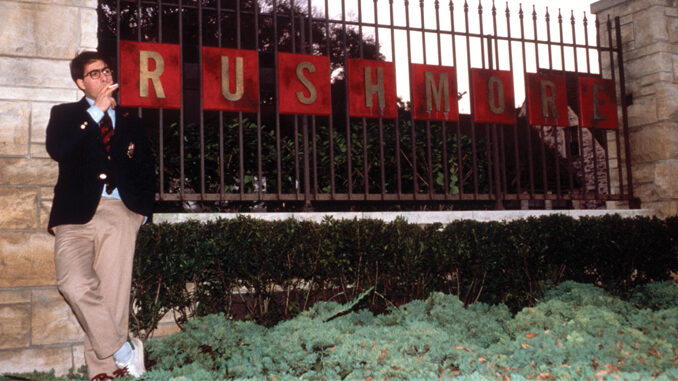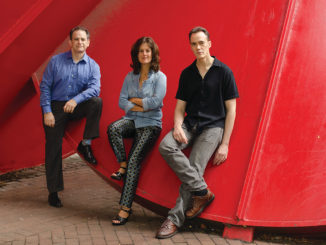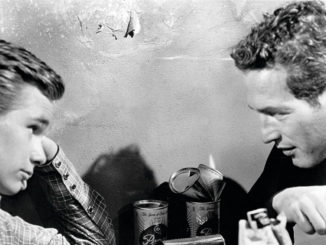
by David Mortiz, ACE
There are those wonderful, albeit rare occasions when you are sent a script and immediately a sense of excitement overtakes you. Such was the case in 1997 when Wes Anderson sent me Rushmore. I felt so…lucky! A couple of years earlier, Wes had championed my cause with producers James L. Brooks, Polly Platt and Richard Sakai to be his editor on his debut, Bottle Rocket. Lord knows, Columbia Pictures tried to introduce him to many other, more experienced editors. But Wes held firm in his choice (a trait the world has since discovered about him) and I was hired.
When the crew assembled in Houston for the shoot, there was true excitement in the air: Bill Murray (!); this new and wonderfully talented kid, Jason Schwartzman; Seymour Cassel; and the others in that great cast.
We were a true Merry Band of Pranksters, being led by our visionary leader. Watching Wes back then was to be witness to a burst of creative energy that was contagious, exhilarating, and a challenge to keep up with. I recall gathering for dailies (wow, so Old School) in a makeshift screening room that we basically built, watching with Wes and DP Bobby Yeoman, my assistant Dan Padgett, and the other department heads. With each new day’s footage, our shared enthusiasm united us.
As we had done with Bottle Rocket, many of the scenes were initially assembled with Wes. He felt very strongly that the first pass, done together, yielded a kind of synergy and spontaneity. So in the evenings––and every weekend––we would get together and go through the “stacks” (breaking the film down into sequences of line readings, take-by-take, angle-by-angle). Wes would make fast and very definite decisions on those takes he wanted.
Now, one may think this mitigates the editor’s input, or could be construed as less than creative in as much as it isn’t the editor alone putting together the first cut. I assure you, it was not the case. To spend the day with Wes and build a scene that he felt confident about regarding performance, shot and angle selection was guaranteed to be one filled with all the minute- to-minute ups and downs that is film editing. Of course, when Wes was not in the cutting room, there were notes to do, as in all films. But it was those first passes with him that stick in my mind…working together as a true team.

After shooting was completed, we returned to Los Angeles for post-production. Editorial moved into a small house on Larchmont Boulevard. It became our home away from home. With people like the Wilson brothers (actors Luke and Andrew), music supervisor Randy Poster, and composer Mark Mothersbaugh pop- ping in to say hello and watching whatever was being worked on that day, there was always something going on. Many nights, it would be just Wes and Dan and me, going through the scenes or, as we were wont to do in the editing room, having the time of our lives laughing and BS-ing about a particular day of the shoot or something in the dailies––generally having a ball. I can honestly say that I knew it was special, I knew it was rare and I knew I was busy creating memories––memories that have rewarded me to this day.
Wes was fond of a particular cutting style, or rhythm, that we dubbed a “Bottle Rocket Cut.” It generally involved keeping things super tight; never letting a character completely enter or exit frame. If a scene had a line that Wes felt didn’t work, it became a challenge to simply cut the line while remaining in the take. Jump cuts, quick cuts, matching-be-damned cuts––to be sure, we weren’t the first to do so. But it was our thing, if you will, and we enjoyed putting those cuts into play.
We also simply reveled in the performances (check out the dynamite salesman). Though the average filmgoer didn’t embrace Rushmore at the time, in the very near future America would indeed catch on with The Royal Tenenbaums. But back then, we would gather after screenings and would, to a man, stand by our little movie––this cool, heartfelt and hilarious film; this labor of love. I also had the pleasure––and again, challenge––of editing The Life Aquatic with Steve Zissou with Wes years later.
Nowadays, I am thrilled by the work Wes does with Andrew Weisblum, A.C.E. Can’t wait for Moonrise Kingdom!
Indeed, there is something very satisfying on a personal level when I watch something new from Wes…satisfying in that I value our friendship so much more, for it is something beyond the director-editor relationship…satisfying in the precious memory that is the time I spent at the Rushmore Academy. It was a time I will always refer to as “My Favorite Year.”





